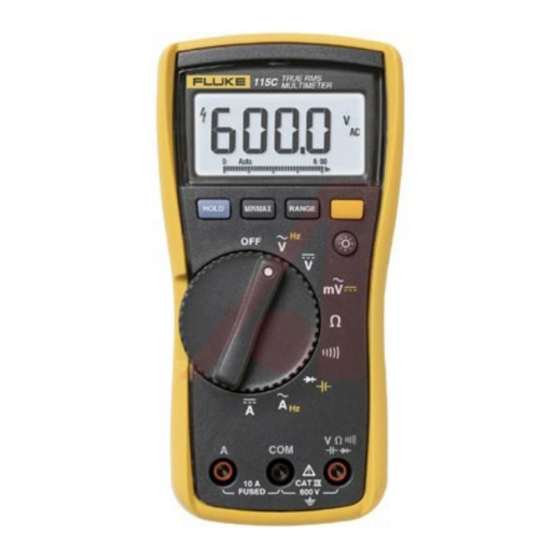Advertisement
FLUKE 112 / 115 TRUE RMS MULTIMETER Quick Start Guide
The Fluke 112 / 115 is a multimeter (volt-ohm-milliameter, or VOM, in some references) designed for
basic circuit measurements. Instrument settings are accessed via the main dial on the front. The
positions (which vary somewhat between the models) are (bold represents the ones we'll use the most):
OFF: instrument off
Return the dial here when you are finished using the meter.
V~~: measures AC voltage (voltmeter)
V==: measures DC voltage (voltmeter)
mV: measures small DC voltages, with higher accuracy
Ω:
measures resistance (ohmmeter)
Note: the ohmmeter setting should never be used on an
energized circuit! It is only used to measure the resistance
of de-energized resistors.
energized component will give incorrect values. At worst it
will blow a fuse inside the meter.
●))): continuity tester (audible ohmmeter).
This is useful for detecting short/open circuits; the system
beeps when low resistance is encountered, so you can check
many connections without looking at the display.
: Diode tester. (We will discuss this later.)
A~~: measures AC current (ammeter)
A==: measures DC current (ammeter)
̶ ) |̶ : measures capacitors
This works similarly to the ohmmeter setting, and should only be used on a de-energized
component. Just as the ohmmeter measures resistance values, this gives capacitance values.
Hz: frequency meter – determines the frequency of an AC signal.
Other buttons:
HOLD: holds the current displayed value on screen. (Useful for copying values into your notes!)
RANGE: selects between auto-range and manual range selection
"Orange" button: used to select "orange" options on dial.
MIN MAX: display the minimum, maximum, or average values of the present measurement.
"sun" symbol: turns on display backlight
To use the meter, you connect two cords (one red and one black) to the bottom terminals as follows:
Black cord: always goes to the COM connector (center)
At best, measuring an
Advertisement
Table of Contents

Summary of Contents for Fluke 112
- Page 1 FLUKE 112 / 115 TRUE RMS MULTIMETER Quick Start Guide The Fluke 112 / 115 is a multimeter (volt-ohm-milliameter, or VOM, in some references) designed for basic circuit measurements. Instrument settings are accessed via the main dial on the front. The positions (which vary somewhat between the models) are (bold represents the ones we’ll use the most):...
- Page 2 When measuring voltage, resistance, diodes, capacitors, resistance or frequency (everything but current!), connect the red cord to the ”V Ω” (etc.) terminal at right. When the red cord is in this position the meter should always be connected IN PARALLEL (i.e. across, not in line with) what you are trying to measure, and the dial should never be on one of the “A”...
















Need help?
Do you have a question about the 112 and is the answer not in the manual?
Questions and answers